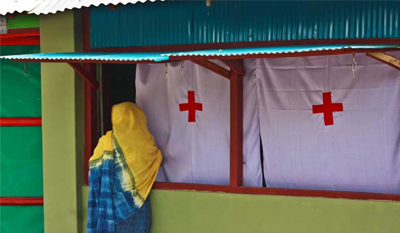Published in The Daily Star on Sunday 26 January 2020
Implementing SDG 3: Revisiting the Revolutionary Medicine
Syed Yusuf Saadat

It was his last semester before graduation. Yet Ernesto Guevara decided to postpone the completion of his medical degree, and instead embarked on an audacious adventure. The ultimate objective was simple: travel from Argentina to Peru, with friend and biochemist Alberto Granado, to get some practical experience of treating leprosy patients. Ernesto’s unwavering commitment to help others, combined with his juvenile wanderlust, took him on a journey across the South American continent that transformed him from being a medical student into a doctor and later into a renegade. Dr Ernesto Guevara went on to become the most iconic revolutionary of modern times—Comandante Che Guevara.
Che Guevara’s legendary journey was described in his memoir “The Motorcycle Diaries”, which was later turned into a biopic with the same title. His subsequent revolutionary activities were also recorded in his autobiographical books, as well as countless other books, movies and documentaries. What often gets lost in the shadows of Che Guevara’s heroic feats is the quiet rebellion against medical conditions and illnesses that he directly inspired. In a speech to the Cuban militia titled “On Revolutionary Medicine”, Che described how his travels brought him into close contact with poverty, hunger and disease, and expressed his fervent wish to help the helpless. According to Che, revolutionary doctors were individuals who utilised their technical knowledge in the service of the revolution and the people. Che envisaged a healthcare system that provided services for the greatest possible number of people, instituted a programme of preventive medicine and created public awareness about hygienic practices. Che Guevara’s ideas and ideals were subsequently enshrined in the Cuban constitution which guaranteed free universal healthcare for all.
However, unlike Cuba, most developing countries struggle to provide quality healthcare to their citizens. The right to good health has been championed in the third Sustainable Development Goal (SDG 3) of the 2030 Agenda. SDG 3 calls upon countries to “ensure healthy lives and promote well-being for all at all ages.” Bangladesh has also made commendable progress on indicators under SDG 3. According to the Bangladesh Bureau of Statistics, maternal deaths per 100,000 births decreased from 648 in 1986 to 315 in 2001. Since 2009, maternal mortality ratios have been declining continuously every year, and in 2017, there were 172 maternal deaths per 100,000 births. Nonetheless, it will be difficult to achieve the government’s target of having a maximum of 105 maternal deaths per 100,000 births by 2020 unless urgent steps are taken.
Apart from the positive outlook of the national aggregate, the difference between rural and urban maternal deaths has also been reduced over the years. For example, in 1995, there were 72 more maternal deaths per 100,000 births in rural areas compared to urban areas, but in 2005, there were only 25 more maternal deaths per 100,000 births. In addition to the fall in maternal deaths, infant mortality has also declined. The mortality rate of children below the age of 5 years decreased from 102.8 deaths per 1,000 live births in 1997 to 32.4 deaths per 1,000 live births in 2017. Neonatal mortality rate declined from 47.9 deaths per 1,000 live births in 1997 to 18.4 deaths per 1,000 live births in 2017. Thus, the country has already achieved the milestones in both under-five and neonatal mortality rates well ahead of 2020.
A key reason behind the decline in maternal and infant deaths is the rise in the number of healthcare service providers. The proportion of births attended by skilled healthcare service providers increased from 20.1 percent in 2006 to 49.8 percent in 2016. The number of nurses per 10,000 people increased from 1.576 in 2007 to 3.067 in 2017, and the number of physicians per 10,000 people increased from 3.193 in 2007 to 5.268 in 2017. However, despite the progress made by Bangladesh in implementing SDG 3, a number of key challenges remain. These include, inter alia, the high out-of-pocket healthcare expenditure, the rural-urban divide in access to quality healthcare services, the unmet needs of people with disabilities, and the neglected issue of mental health.
Developing countries like Bangladesh have much to learn from the public healthcare system of Cuba and from Che Guevara’s theory of revolutionary medicine. In the book titled “Primary Health Care in Cuba: The Other Revolution”, Linda M. Whiteford and Laurence G. Branch outline ten lessons learned from Cuba’s primary healthcare model that may guide the way forward for other developing countries with similar resource constraints.
These include: i) reducing disparities in healthcare access, opportunities, education and resources to improve overall well-being; ii) ensuring a strong presence of healthcare service providers everywhere as a prerequisite for universal healthcare; iii) developing trust between healthcare service providers and the people they serve through ensuring accessibility and reliability of healthcare services; iv) empowering local community groups to collect data and to participate in healthcare promotion campaigns; v) communicating public health awareness messages clearly and frequently; vi) making an indefatigable political commitment to improving health for all, through prioritising health policy; vii) emphasising disease prevention as an overarching public healthcare strategy; viii) achieving a health policy consensus by fostering a sense of equality for all, while acknowledging resource constraints; ix) creating behavioural changes through community interventions and individual counselling, in order to reduce health risk factors; and x) building a strong preventive primary healthcare system which is community-based, labour-intensive and relatively technology-independent.
Bangladesh can learn from the Cuban experience to address the challenge of providing quality healthcare services to all its citizens.
Syed Yusuf Saadat is a Senior Research Associate at Centre for Policy Dialogue.

